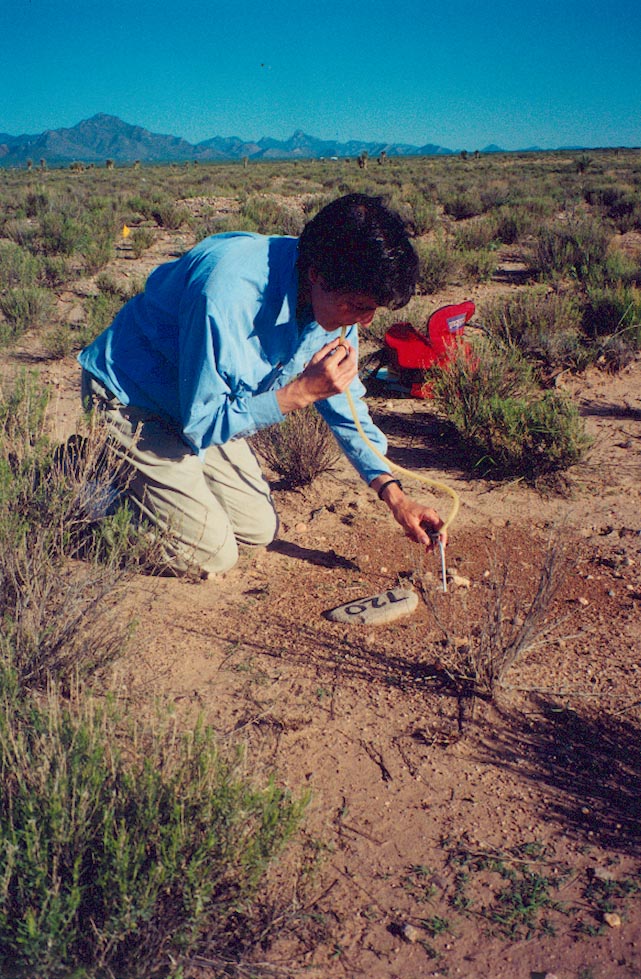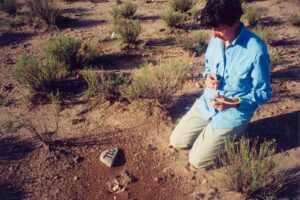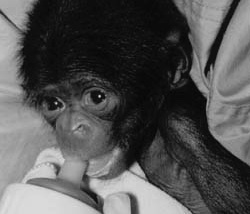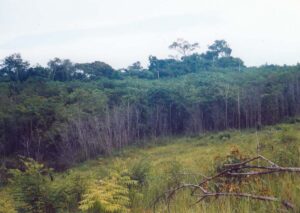Sunrise refracts over the Peloncillo Mountains, sending tendrils of light along the ground where biologist Deborah Gordon kneels in the dirt with an aspirator, sucking up dozens of ants. We’re in the desert a few hours drive from Tucson, where Arizona meets New Mexico, a sandy intersection that has provided the material for Gordon’s career-long quest to understand the social structure of this particular species of harvester ant, pogomyrmex barbatus. “Hitler could come to power and I wouldn’t know it,” Gordon murmurs, adjusting her wide-brimmed straw hat. “I’d be out here, sucking up ants.”
Thwap! One moment the ants are tidying up their nest; the next they’re swept through a plastic tube to the bottom of her small glass vial. Gordon will chill these ants in a cooler (they respond to the cold by curling up, which will allow her to mark their backsides with green non-toxic model airplane paint). When they stir, she’ll return them to the nest, then laboriously track the peregrinations of individuals over the next several days. She’ll compare what happens in this colony to another one nearby.

This meticulous procedure is typical of animal behavior research in the field, in which scientists study the interactions of animals in nature. “You can take the ants into the laboratory, but then you don’t know if what you’re seeing eliminated important factors,” Gordon explains. “People talk about ‘eliminating the noise,’ but of course you never really eliminate the noise. Variation is precisely what makes the work so interesting.”
Through this kind of tracking over the years, Gordon has found that workers rapidly switch jobs when conditions change. In an array of experiments Gordon has simulated floods, storms, and attacks by neighbors and then charted the colonies’ varied responses. She’s chronicled the inter-relationships between colonies, trying to crack the code of how ants together respond to change.
A pioneer in the study of how ant colonies respond to one another, and to changing environmental conditions, over time, the 43-year-old biology professor from Stanford University has spent the past 20 years trying to understand the dynamic patterns of organization which ants — on the earth since before dinosaurs died out — have refined. What the biologist has discovered by charting the life cycles of 300 ant colonies spread across a 25-acre swath of chapparal are findings which upset many of our assumptions about how the world works.
If your knowledge about ants is informed primarily by feature film animators — as in Antz or It’s a Bug’s Life — much of what you’ve learned is probably wrong. Forget about Hollywood’s he-man soldiers and workers constrained by class. Colonies are actually populated primarily by non-reproductive females which do the heavy lifting: Building the colony, seeking out food, defending terrain, raising, tending, and feeding the next generation. Males have a restricted role lasting only a few weeks; they prepare for a single flight, attempt to mate with the new queen and then promptly expire. (“The males have smaller heads,” Gordon says cheerfully.)
There’s certainly no royal hierarchy, with queens giving orders through generals. Queens are no imperial figures; they’re really just the colony’s ovaries. Since colonies are superorganisms — meaning that ants are more akin to cells in a body than to autonomous individuals — it’s highly unlikely that a worker ant, like Woody Allen’s character,Z, in Antz, has ever risen from a psychiatrist’s couch to warble the ubiquitous modern plaint: “I’m supposed to do everything for the colony, and what about my needs, what about me?” And about that supposition that ants are the model of industriousness (“Look to the ant, thou sluggard,” the Bible advises in Proverbs), Gordon surmises that three-quarters of the ants on any given day are just hanging around downstairs.

The central mystery about ants is how such unindustrious, bumbling creatures accomplish so much, without hierarchy and without anyone calling the shots. “The basic mystery about ant colonies is that there is no management,” Gordon writes. “A functioning organization with no one in charge is so unlike the way humans operate as to be virtually inconceivable.”
Nothing in her childhood hinted at a future in science. Raised as the middle child between two brothers, Gordon grew up in the cozy confines of an upscale Jewish neighborhood in Miami Beach, Florida, the precocious daughter of a well-known politician who served first on the school board before moving into powerful positions in the state legislature. Gordon remembers feeling, as a young child, that her every move was being meticulously scrutinized. “I’m out here partly because it’s so open, nobody’s watching” she murmurs, looking across the desert expanse. “I’m insignificant in it.”
Gordon’s early passions — mathematics, music, and writing — were stoked by her mother, Barbara, a linguist who pressed her daughter to shine intellectually. “She was afraid that I would be ordinary,” Gordon remembers. After streaking through elementary school, Deborah was sent away at 12 to an exclusive private school in Vermont. After finishing high school at 15, she spent two unchaperoned years in Madrid and then Paris, studying Spanish, French, and still more music. “What I liked about it was taking a beautiful piece of music and finding out that it has a structure and there are rules,” she remembers. “To me, it was thrilling to find out how a fugue works.”
In Paris, Gordon got the news that her mother, then only 42 years old, had breast cancer. Barbara Gordon grew distrustful of her doctors after a radical mastectomy and heavy radiation, believing that her health had been damaged by overly aggressive treatment. Over the next nine years, through Deborah Gordon’s undergraduate years and her graduate training, her mother battled recurring cancer.
At Oberlin College, Gordon continued studying musical theory and French, but then in her senior year, a course in comparative anatomy shifted her trajectory. “I thought I would arm myself with the knowledge not to let doctors do to me what they’d done to my mother,” Gordon recalls. She headed off for a master’s degree in biology at Stanford, floundering a bit afterwards before entering the Ph.D. program in zoology at Duke University.

Tumbling on into the work with ants was almost entirely serendipitous. “I was thinking about embryos,” she recalls. “An embryo starts out with two cells and they divide and divide and divide — the technical term is differentiate. They become different kinds of tissues. To understand why each cell is going to do what it does, you have to look at the context of the other cells around it. That’s the question I started with.”
Instead of pursuing that question under the microscope in a laboratory, though, “I wanted to work with something I could see,” Gordon says. Just as she prepared for her first summer of field work in the desert, Deborah’s mother died of liver failure at the age of 51. “When she was gone, I found this hole everywhere,” Gordon remembers. Bereft, she felt the burden of her mother’s high expectations for her as she set out to Arizona.
Little flags and painted stones mark the locations of her 300 nests of harvester ants scattered between Mormon tea and velvet mesquite. The heat is so intense that the ants work above ground from sunrise until about about noon. Gordon and her graduate student helpers rise each morning about 4:30, eat in the cafeteria of the Museum of Natural History’s Southwestern Research Center, and then head out for seven hours of observation until the temperature drives the ants below ground — and the researchers back to their field laboratory.
Each morning on her daily rounds, Gordon makes a detailed report: Which colonies are moving? Which have had their openings plugged by a sneaky, neighboring species, the Aphaenogaster cockerelli — a larger, more graceful ant which fools the harvesters into staying below by piling rocks over their nest entrances? Where have colonies died? And where are new nests emerging?
In the late 1980s, this research led to Gordon’s finding that older colonies responded in more mature ways to the perturbations they face. Among other things, older colonies proved less likely to engage in sustained, and distracting, skirmishes with their neighbors, while younger colonies reacted far more aggressively in fighting over territory no matter the consequences. Since worker ants only live for a year, these observations were especially intriguing. The change couldn’t be rooted, then, in behavior learned by the ants.
“Instead, something about colony organization must change as the colony grows older and larger,” Gordon writes in Ants at Work. As the colony’s population grows, ants encounter one another more frequently. These patterns of interaction in a changing environment, may hold the key in explaining how a colony becomes more than the sum of its parts. Perhaps, Gordon surmises, the changing architecture of the colony itself — the size of its chambers, the length of its channels, its internal organization — serves as a kind of memory for the ants.
Out on the land, Veronica Volny, a doctoral student trained in genetic analysis, threads her way through the milkweed and acacia to one of the larger harvester ant nests neatly marked with a painted stone. She’ll take 50 ants from more than 150 colonies, return to the laboratory and grind them up. By mapping genetic markers in a colony-by-colony analysis, Gordon and Volny will, at long last after several efforts to do so, attempt to establish the genetic links between colonies. This is a step no one else has taken yet, one that could allow Gordon to establish how the colonies are related and then pin down which behavioral characteristics may be inherited.
Gordon bounces between two colonies of harvester ants of about the same age, the same two nests where she’d painted ants day before. In one colony, the inhabitants have been up early, energetically patrolling and collecting food. At the other nest, just a stone’s throw away, there’s only a desultory group ambling around — and it’s already eight. Perhaps the difference in activity can be explained by location, the proximity of the sneaky Aphaenogaster, or infection in the nest. But if she’d limited her attentions to just one of these colonies, especially if that meant removing a single colony to her laboratory rather than comparing life histories of colonies in the field, Gordon knows she could have made misleading conclusions.
Gordon is painfully aware that her two decades of study opens only a narrow window on ant evolution, already played out for 100 million years. Still, from the study of tiny insects on this patch of desert ranchland, Gordon struggles with the largest conceivable questions. They’re posed by patterns of organization utterly different from our own, in a society with no leaders, creating the puzzle that Gordon keeps re-working in her mind as she makes her daily rounds.
Understanding “the otherness” of nature is important, she implies, because doing so pulls us out of our own skins, forcing us to consider radically unfamiliar phenomena on their own terms. In conversation, Gordon sometimes makes analogies to human life in talking about the ants, but then reprimands herself for committing the cardinal sin: anthropomorphosis. “What I’ve learned about ants doesn’t say anything about how human society operates,” she confesses sheepishly.
Gordon thinks it’s precisely the alien character of colony organization (she’s not fond of fuzzy popularizations about the beauty, synchronicity, and “clockwork” quality of natural systems. “Nature is not like clockwork,” she says), which may prove the most illuminating for science over time.
Perhaps, she even surmises, the structure of colonies will end up generating important clues about the intricate workings of other complex systems such as computer networks, embryos, even the human brain. “You could dissect a brain into millions of separate nerve cells but would never find any dedicated to thinking about ‘nature,’ or ‘ants,’ or anything else; thoughts are made by the shifting pattern of interactions of neurons,” she writes.
Asked to elaborate about the ways in which ant colonies may resemble the architecture of brains, Gordon says, “It’s not so much that I think ants are going to teach us about brains or that brains are going to teach us about ants. But when we understand an ant colony, we might know a bit more about how to understand a brain.”
In a sense, Gordon suggests, ants may well help explain how, in varied biological systems, a sum becomes more than the collection of its parts — among the central mysteries of both life and science. That’s a heavy responsibility to load on to the lowly ant, but two decades of study have led Gordon to look for such large meaning in the intricate patterns of these social insects.
©2001 Doug Foster
Doug Foster, a freelance writer in Berkeley, California, is examining animal behavior research.



